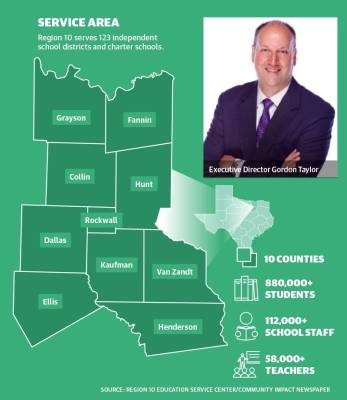“We’re nonregulatory, and that is a key factor,” Region 10 Executive Director Gordon Taylor said, noting Region 10 is not a regional office of the Texas Education Agency. “I can’t and don’t tell any of the local education agencies what to do. We’re here to provide services and help them be better at what they do.”
Where does funding for Region 10 come from?
The funding for us, for the most part, comes from school districts. We receive a very, very small legislative appropriation every year. If you look at our annual audit, roughly a third [of Region 10’s funding] comes from the sale of services to schools. A third of it comes from federal or state grants that we are asked to administer on behalf of TEA. And then the other third is that we [are the fiscal agent for] shared service arrangements and cooperatives of schools.
How often does Region 10 offer professional development opportunities?
I would say that’s the bread and butter of what we do—it probably makes up half of the services we provide. They occur year round. The heaviest time period would be August, when teachers and other educators are returning to campuses from summer break. They go on in the fall and winter and spring as well.
Since you are located in Richardson, do local districts end up using your services more often than the districts farther out in your service area?
It’s a fairly balanced thing, but depending on the size of the district, they’re going to use us differently. [Larger districts] are going to use us to supplement what they’re providing internally in terms of professional development. [When] you get into medium-sized districts, that is still going on, but we’re also picking up some of the things that [larger districts] might be doing on their own. Then in the very small districts, those with 1,000 students or less, in a lot of ways, we’re probably operating as their central office staff.
What kinds of services did Region 10 provide when schools were closed due to the pandemic?
We put together a response [plan] and then executed it pretty quickly [by] getting a lot of our instructional technology people geared up to work with teachers and administrators. We spent an enormous amount of time on the phone and on Zoom calls, working with the instructional people ... finding what they needed, creating forums where they could share with each other [and] acting as a repository for a lot of the material that was either created or brought together. Then we operated a lot as a central information hub.
What do you think is the biggest issue facing school districts?
The return of students to classrooms this August and September will not be like it was last year, nor will it be like it was in 2019 and before. Everything’s going to be unique this fall. It’s not like we froze everything and can unfreeze it and start over. There’s part of normal life that is going on the schools have to deal with as well as the pandemic-related issues.






